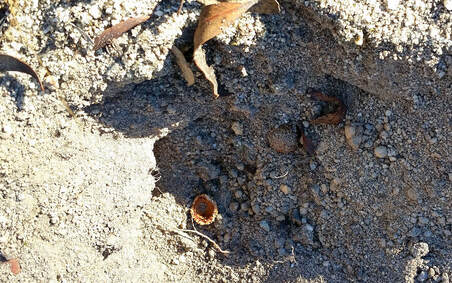Despite an exceptionally dry summer and autumn, we have had over 90mm of rain since mid June. If it all soaked in it would wet the soil to at least 2.5 metres. There has been relatively little runoff and I was gobsmacked, and very concerned to find dry soil within 5cm when digging side-drains on a range of soil types on walking trails to reduce erosion. These soils are massively water-repellent.
 the quandong seed above was buried by a woylie that later dug it up to eat
the quandong seed above was buried by a woylie that later dug it up to eat
Woylies and emus have gone from most of our reserves with the only burrowing animals being rabbits, reptiles and echidnas. This is having a massive impact. Over time as plants die leaving bare ground and roots rot away there is less chance that new plants will replace them unless conditions change.
When entering Foxes Lair from opposite the caravan park, one can see poorer shrub and wildflower growth on the left side that hasn’t been burnt for over 50 years on the left, compared to vibrant growth on the right where an arsonist burnt about a third of the reserve.
That fire was a real revelation for me, as it triggered orchids I hadn’t previously seen and rejuvenated small bird life such as quail that hide in dense undergrowth.
The arsonist had several goes in Foxes Lair After a small attempt I noticed a smouldering front moving through the soil under marri that burnt the water repellent organic surface layer to a depth of 3cm, and after the arsonist’s finale the fire continued to burn along underground tree roots for about 3 weeks (lesson here don’t walk through burnt country soon after a fire – your foot can plunge into underground burning root). The images below shows the difference burning made on the Valley Walk.
Over time I have developed the following achievable strategies in Foxes Lair.
- Proper low intensity mosaic burns, with raking around big standing dead trees that are vital nesting spots. I developed a 10 plus year interval burning program for blocks in the reserve (no luck with implementation so far).
- When pruning is required or trees fall across tracks etc. prunings are placed on bare areas to help trap water (amazing how quickly the leaves disappear).
- Dig small side drains at short intervals along trails and roads to return water to the bush more evenly.
- Spread soil from these side drains on to bare areas to introduce and retain seed and help water infiltration.
- Control weeds (so many).
- At the rate that large nesting trees are falling over, I reckon that nesting boxes will be needed one day.
I would hate Australia to go down that route.





